Article Performance
Data from Ahrefs
-
Linking websites
The number of websites linking to this post.
Get the week’s best marketing content
You don’t need another debate about whether optimizing for AI counts as SEO. You need to know what to actually do.
This checklist combines proven SEO essentials with the new steps that matter for AI search. No fluff, no fuss.
It will help you strengthen your SEO foundation, adapt to changing behaviors in AI search, and keep your brand visible across every platform people use for answers.
Download our ultimate SEO + AI Search checklist for free
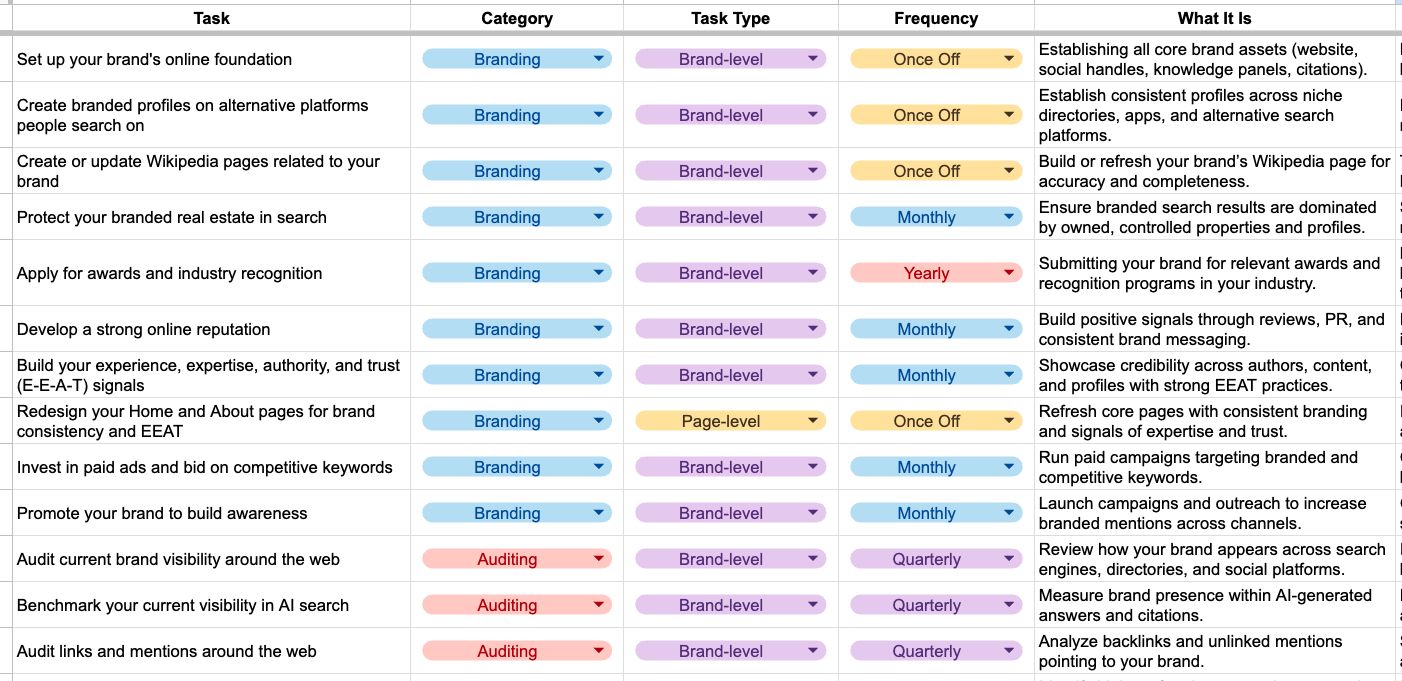
Download this checklist combining core SEO tasks with new tasks for AI search and share it with your team:
Each item in this checklist is short and scannable, but you can click the links for detailed explanations and step-by-step how-tos.
Set up your brand’s online foundation: Create a logo, brand colors, and messaging doc, and ensure that they are used consistently everywhere you have an online presence. Ensure your brand story and product categories are clearly connected.
Create branded profiles on alternative platforms: Ensure your profiles are consistent across social media, directories, apps, and niche platforms. Doing so expands your brand recognition beyond Google and Bing, including on Reddit, TikTok, YouTube, and other platforms where people search.
Create or update Wikipedia pages related to your brand: For big brands, ensure your Wikipedia entry is complete and accurate, providing one of the most trusted references for both search engines and AI models.
Protect your branded real estate in search: Ensure that your branded search results are filled with pages you own, such as your website, social profiles, and listings. This stops competitors or negative results from taking valuable positions.
Apply for awards and industry recognition: Submit to relevant industry awards and recognition programs to enhance your perceived authority, credibility, and visibility in traditional and AI search results. Feature these prominently on your website to build trust and increase conversions.
Encourage happy customers to leave reviews: Build trust and develop a strong online reputation with positive reviews on Google, Trustpilot, and recommendations from users in online communities like Reddit.
Build your experience, expertise, authority, and trust (EEAT) signals: Strengthen EEAT signals at a brand, website, and page level to win favor with search engines and AI platforms. Start by adding clear author bios, publishing expert credentials, and showcasing trusted reviews.
Check your Home and About pages for brand consistency and EEAT: Consider redesigning your homepage (and other core pages) to ensure branding is consistent and you showcase clear trust signals, such as reviews, testimonials, awards, or certifications.
Invest in paid ads and bid on competitive keywords: Google Ads and SEO can work together to increase brand awareness and demand, ensuring your name appears alongside (or above) competitors in key searches.
Promote your brand to build awareness: Spark branded searches on Google by running social ads or email campaigns that highlight a unique offer and prompt people to search for your brand directly.
Audit current brand visibility around the web: Review how your brand appears across search, directories, and platforms to uncover inconsistencies like:
- Different brand names (e.g., Domain vs The Domain Group)
- Old logos or inconsistent taglines
- Old addresses or phone numbers
Benchmark your current visibility in AI search: Track how often your brand appears in AI-generated answers to establish a baseline for future growth.
Audit links and mentions around the web: Use tools like Ahrefs’ Site Explorer to find lost, unbranded, or broken links and reach out to the website owners to reclaim them. You can also use Brand Radar to audit your brand mentions. Benchmark the number of mentions and compare with competitors to spot gaps you can fill.
Audit your top pages visible in AI responses: Improve those that are underperforming, update those doing well, and improve their accuracy and business value.
Audit your content completeness and topic coverage: Use AI Content Helper to evaluate whether your content fully covers subtopics and intents, ensuring comprehensive topical authority.
Identify decaying content and update it: Refresh outdated pages with new information and links to recover rankings and preserve visibility in search and AI. To find decaying pages, look for:
data-nobefore
- Dropped rankings for relevant keywords
- Fewer mentions in AI responses for key terms
- Decreased organic and AI traffic in analytics
- Outdated data or information in the body content
Audit competitors to find gaps or new opportunities: Analyze competitor keywords, content, and formats to uncover areas where you can differentiate and outperform. Reverse engineer competitor visibility to find gaps to fill or new untapped opportunities.
- Do a brand gap analysis
- Do a content gap analysis
- Do a link gap analysis
See what AI says about your brand and if it’s true: Check the accuracy of AI answers about your brand to catch errors or misinformation early.
Do an AI brand gap analysis to close gaps against competitors: Compare your AI visibility with competitors and prioritize strategies to strengthen your presence.
Most SEO implementation (especially for AI search) relies on how you create and structure your content. Here are some things to think about for every page you create.
Build topical authority
- Publish original data like research and statistics: Release proprietary studies and benchmarks that attract authoritative backlinks and establish subject authority.
- Keep your most cited pages fresh and improve their business value: Regularly update pages that AI frequently cites and strengthen the business value of those pages to convert more visitors who find you in AI search.
- Close topic gaps to win visibility for new queries: Expand into emerging or missing subtopics to reinforce topical relevance and AI recognition.
- Create content hubs around core topics and long-tail keywords: Start by identifying your main pillar topic (e.g., ‘email marketing’) and then list related subtopics (e.g., ‘subject lines,’ ‘A/B testing,’ ‘deliverability’) to build cluster pages that link back to the pillar.
- Find questions to answer in your content: Find questions your audience is actively asking to capture demand in both traditional search and conversational, AI-driven search.
- Use Ahrefs’ Keywords Explorer to find common questions searched on Google
- Mine Google Search Console data for the questions people ask that lead to your site
- Use Answer the Public and Also Asked to find questions related to a given topic
- Analyze People Also Ask questions on Google for core keywords
- Review internal call transcripts and support tickets to find FAQs that existing customers ask
- Gather ‘voice of customer’ data via surveys and interviews
- Create an SEO topical map that extends beyond keywords: Start by identifying your core topics and related subtopics that have strong relevance to your brand and potential to drive traffic to your website. Map these topics to existing pages on your website or plan new pages to close topic gaps.
- Update your content strategy for AI search: Adapt planning and content strategy processes to prioritize AI-specific opportunities alongside SEO, like:
- Identifying pages or content hubs that should be cited in AI responses but aren’t
- Finding topic gaps against your competitors
- Uncovering untapped topics your competitors have yet to discover
Content quality and credibility
- Provide clear author or team bios and create dedicated pages: Publish detailed bios showcasing expertise to strengthen EEAT signals.
- Interview experts and quote them in your content: Add unique, authoritative perspectives that make content more trustworthy and AI-citable. Include expert quotes, cite and link recognized experts in your field, and reference authoritative sources in your content.
- Adapt your writing tone to match the content format: Tailor voice for blogs, guides, or sales content to improve resonance and engagement. For example, opt for a conversational tone where possible. Use a declarative tone when answering a question. Lean into an authoritative or expert tone for a ‘how to’ section and so on.
- Optimize content for actions or jobs-to-be-done instead of just questions: Frame content around outcomes and tasks, not just query-based answers. Then, instead of just writing an article that answers a query, give users a resource that helps them complete the action (e.g., a template for ‘creating a content calendar,’ or a calculator to ‘track ROI’).
- Define technical terms the first time you use them in content: Explain jargon concisely to make material accessible for broader audiences. It also sets the scene for AI systems to interpret and categorize your content correctly.
- Enrich content with original multimedia, like video, images, or audio: Add engaging formats that enhance experience and provide additional AI-referenced material. This can help secure visibility across more search surfaces that lean toward different types of content.
Structure and readability
- Emulate content formats AI frequently cites for your topic: Study successful content in AI responses and mirror those structures, such as step-by-step guides, comparison tables, checklists, FAQs, or how-to tutorials.
- Start your content with a TL;DR summary section: Provide condensed key takeaways upfront to help users and AI grasp value instantly. Here’s an example of what that looks like:
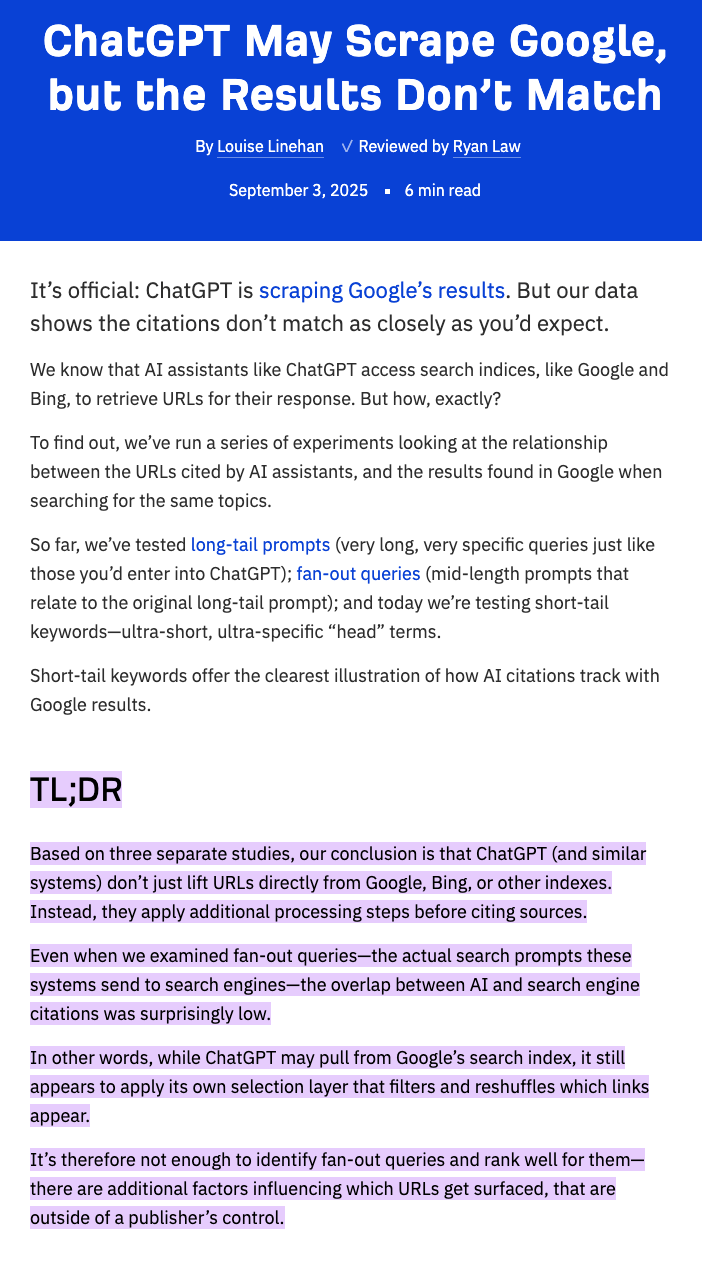
- Make sure your content is logically structured and scannable: Use clear sections, short paragraphs, and an information hierarchy that naturally leads from one section to the next. This helps readers (and AI) follow the flow of ideas without hitting dead ends or jarring jumps.
- Implement answer-oriented writing with one idea per section: Write clear, direct content with each section focused on a single point. Lead with the bottom line, then support it with context, anecdotes, or examples. This timeless writing approach now also improves visibility in both SEO and AI search.
- Use headings to create a logical content hierarchy: Organize content with a single H1 containing your primary keyword, supported by H2s and H3s that reflect the natural flow of topics. Headings should guide readers through the topic, making complex material easier to scan, while also helping search engines and AI understand context and relationships between sections. Do not apply heading tags purely for visual effect.
- Use bullet points, numbered lists, and tables to provide clarity: Present data in concise, structured content formats that improve both readability and snippet eligibility. For instance, avoid uploading tables as images. Use HTML or text-based tables so search engines and AI can read them.
- Add relevant FAQs for which you can write an original answer: Create FAQ sections that answer common user questions and that you can provide original, worthwhile answers to. The more your responses add information gain to the content, the more likely they will appear in AI search responses, too.
Classic on-page SEO
- Include a keyword in your page’s URL slug: Use short, descriptive slugs with the target keyword to strengthen relevance signals.
- Add a compelling title tag with the main keyword included: Write concise, keyword-rich titles that maximize click-throughs and topical alignment.
- Add a conversion-optimized meta description: Craft persuasive descriptions that highlight benefits and encourage clicks from SERPs.
- Internally link related pages and articles to each other: Add internal links between topically related pages on your website.
Content distribution & repurposing
- Repurpose your content and distribute on multiple platforms: Repurpose your top content into multiple formats (e.g., videos, carousels, podcasts, infographics) and distribute them across platforms that are gaining visibility in AI and search, like LinkedIn, YouTube, and Reddit. In short, squeeze multiple formats out of one winning piece of content and get it in front of more audiences.
Build links and brand mentions around the web: Earn references from trusted publications to strengthen authority and AI recognition.
Get links and mentions near topics that matter to your business: When backlinks and anchor text are tied to your core topics, they strengthen your topical authority instead of diluting it. Focus your outreach on sites, articles, and conversations where your brand naturally fits the topic, so search engines and AI associate you with those themes.
Partner with writers already getting cited in AI responses: Collaborate with authors frequently surfaced in AI answers to boost visibility in content already surfaced by search systems and discovered by humans. You can use the Cited pages report in Ahrefs’ Brand Radar to find top pages for your topic and then reach out to the people who wrote or edited them
Publish guest posts on publications with strong visibility in AI responses: Contribute content to outlets often cited by AI.
Create shareable assets that naturally attract links and mentions: Design tools, visuals, or templates people want to reference. Or share original thought leadership, thought-provoking opinion pieces, and data studies that can naturally attract links. For example, this data study by a marketing agency led to multiple links earned from major news outlets sharing news and updates about Taylor Swift’s jet emissions. 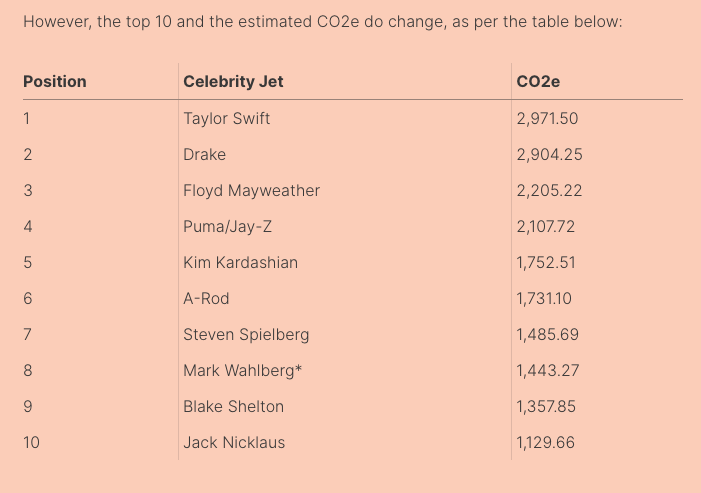
Clean up inconsistent brand information or misinformation on third-party sites: Fix errors like outdated addresses, old logos, broken links, or incorrect descriptions to maintain trust and entity clarity.
Reclaim lost backlinks and mentions to maintain visibility: Track down broken or removed links on partner sites, news articles, or directories, and ask site owners to reinstate or update them.
Contribute to relevant conversations on forums and discussion threads: Join industry-specific spaces (e.g., Reddit communities, LinkedIn groups, or specialist forums) and answer questions where your expertise is useful. Be authentic and helpful so mentions of your brand feel natural.
Find the most cited pages for your topic and get mentions in them: Find pages AI frequently cites in its responses and add these to your link outreach so you can get mentions and links on them. Doing so could lead to faster increases in AI visibility for your brand.
Site Audit and schedule ongoing crawls: Run automated audits to catch issues before they impact visibility. The tool flags hundreds of potential problems and ranks them by importance, so you know what to fix first. Enterprises with large websites can also use Patches to resolve issues affecting search visibility without needing developer involvement.
Use HTTPS for content and website security: Secure your site with SSL to meet baseline ranking and trust signals.
Check robots.txt allows AI bots to access your content: Ensure you’re not accidentally blocking AI or search crawlers.
Update your XML sitemap and submit to Google and Bing: Keep sitemaps fresh to improve the discoverability of important pages.
Create a clean and crawlable site architecture: Organize navigation and hierarchy for better crawling and indexing.
Ensure fast-loading pages: Optimize performance for both user experience and rankings. Try optimizing file sizes, minifying CSS and JS, using browser caching, and implementing a content delivery network like Cloudflare.
If you use Cloudflare, check that it’s not blocking LLM access: Cloudflare has added many new settings controlling how AI platforms can access your website, often setting the default to block AI platforms. Check that these defaults aren’t applied to your account; otherwise, your website likely won’t surface in AI responses.
Measure and improve Core Web Vitals: Track and optimize loading, responsiveness, and stability metrics.
Implement structured data: Add schema to improve machine understanding of your content and how your pages appear in traditional search results. Semantic HTML can also help turn your content into structured data that search engines and AI systems can interpret more accurately.
Apply hreflang for multilingual and/or multiregional content: Use hreflang to deliver correct content versions internationally.
Optimize your images for speed and performance and add alt text: Compress and label images for accessibility, SEO, and AI recognition.
Use server-side rendering for visibility to search and AI crawlers: Pre-rendered pages ensure search engines and AI systems can index everything, even if your site relies heavily on JavaScript.
Prioritize mobile-first and responsive design on mobile devices: Build mobile experiences as the default for indexing and AI.
Redirect broken pages and URLs hallucinated by AI: Catch errors and direct users to relevant content.
Create and optimize business profiles on Google, Bing, and Apple Maps: Claim and complete listings with accurate information.
Create location pages on your website: Publish content for individual cities or regions to strengthen local rankings.
Ensure consistent name, address, and phone number (NAP): Keep NAP data standardized everywhere your business appears online.
Build localized citations in your region: Submit consistent NAP information across trusted directories like Yelp, Yellow Pages, or industry-specific sites.
Keep your business profiles updated and post on them regularly: Maintain active listings to improve visibility and AI trust, as well as to provide accurate information to searchers in your area.
Web Analytics to measure your website traffic: Track organic, paid, and AI performance. Find pages earning the most traffic and conversions.
Set up Google Search Console and Bing Webmaster Tools: Gain insights into indexing, crawling, and performance issues.
Set up your internal reporting dashboard to measure brand awareness: Centralize reporting on branded search and mentions.
Monitor your top pages and organic traffic from SEO and AI: Track performance of priority content across both ecosystems. You can do this using Ahrefs’ Web Analytics: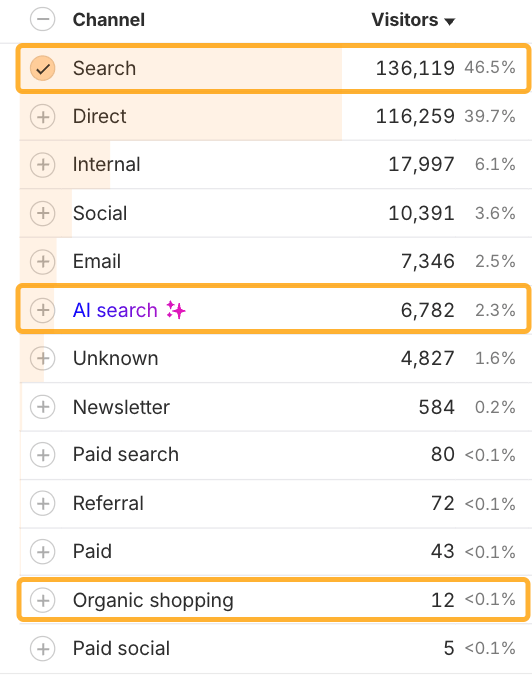
Check out the list of top pages by each channel to see which perform best in traditional SEO results vs in AI search specifically.
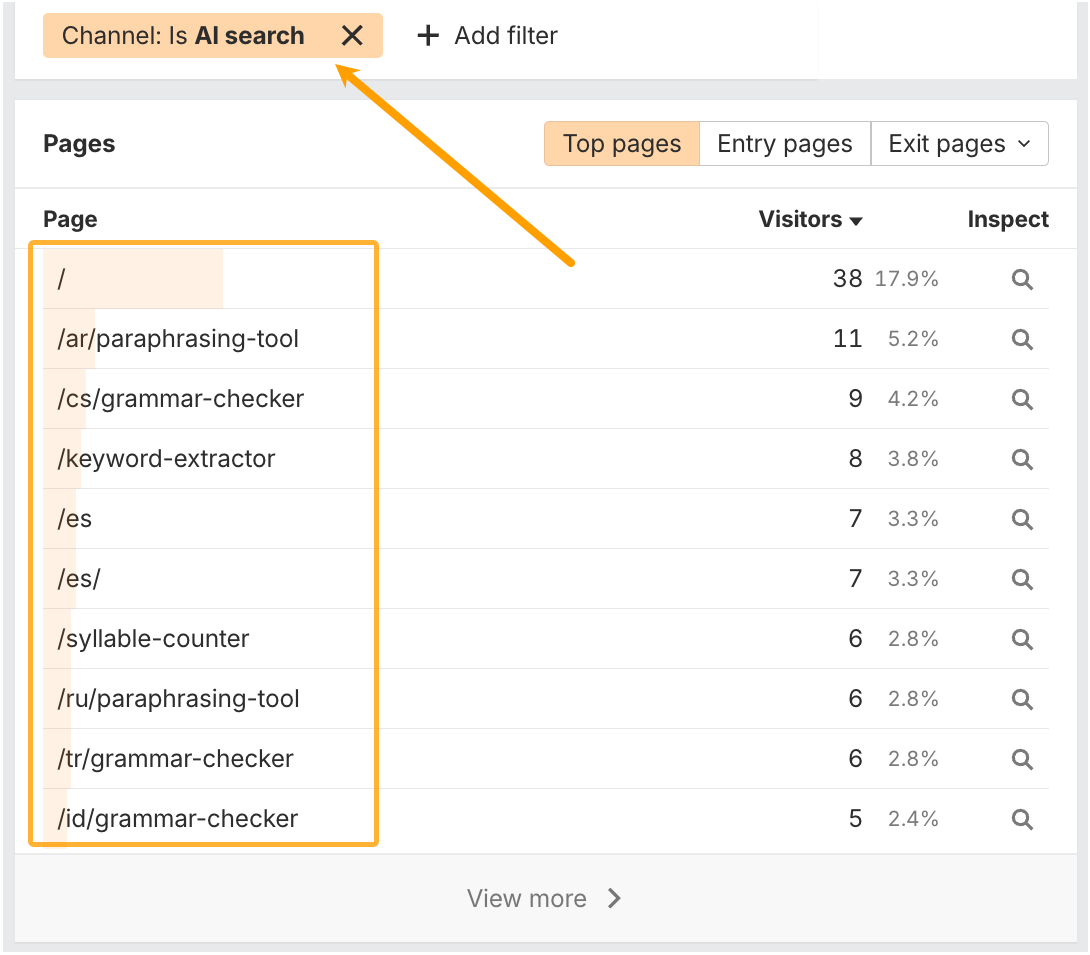
Track rankings in the top 20 organic positions: Monitor keyword movement in the top ranking spots to assess meaningful gains and losses.
Track growth in links and mentions around the web: Use Ahrefs’ Brand Radar > Web visibility report to see whether your brand is earning more backlinks, citations, and references over time. 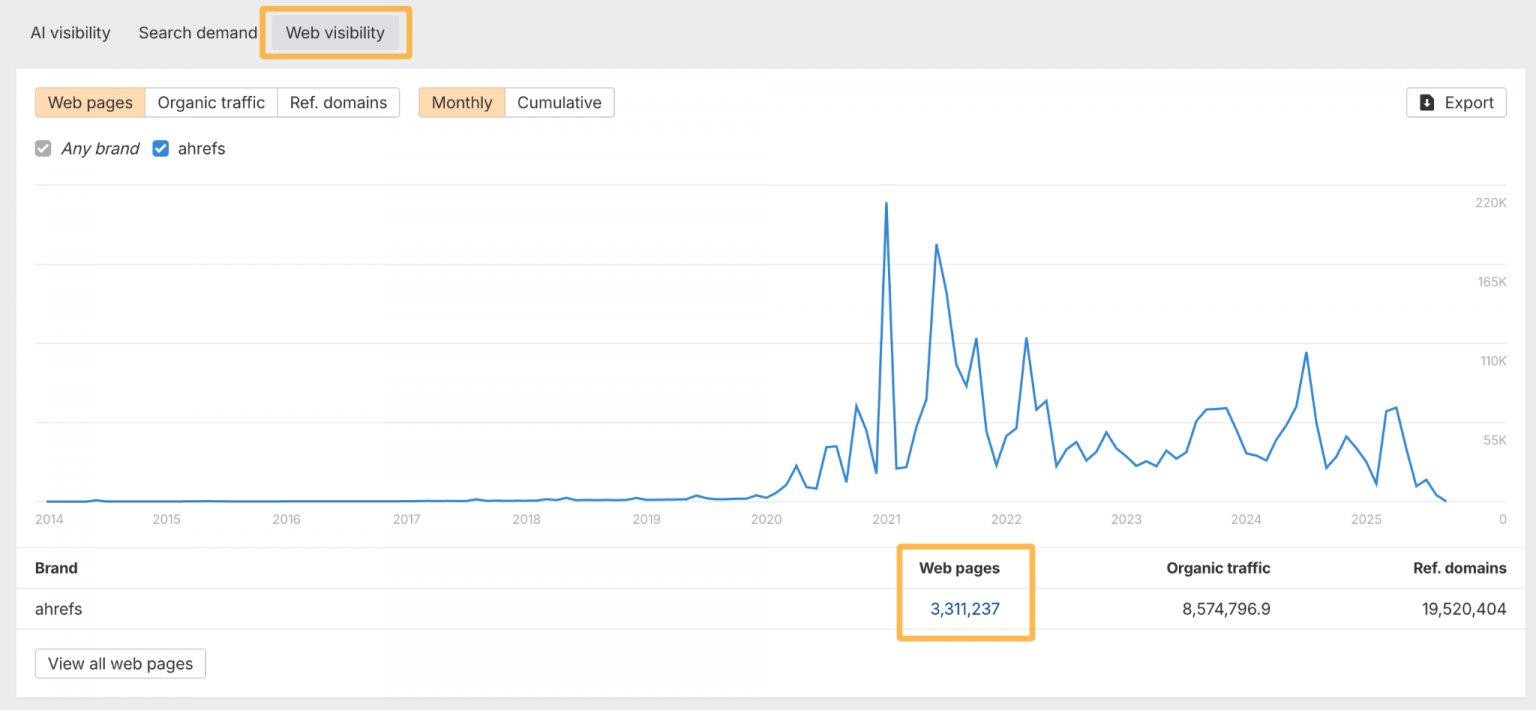
Measure your AI Share of Voice compared to competitors: Benchmark your presence against rivals in AI search. 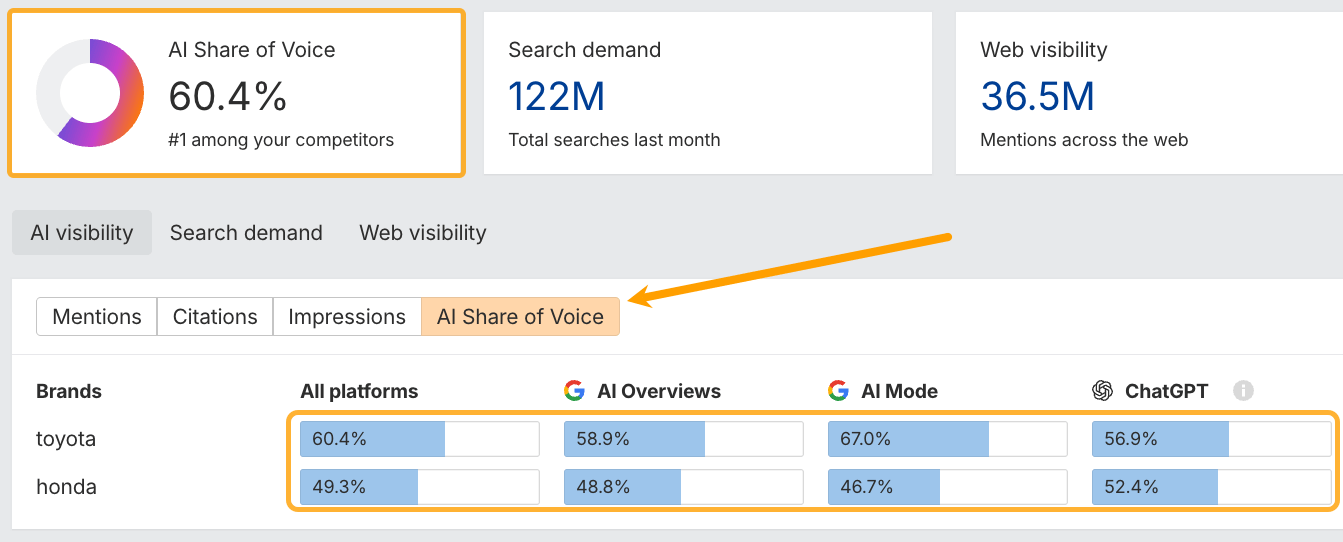
Measure your brand’s appearances in AI answers: Track frequency of AI citations, including your brand across platforms. You can do this in Ahrefs’ Brand Radar > AI responses report: 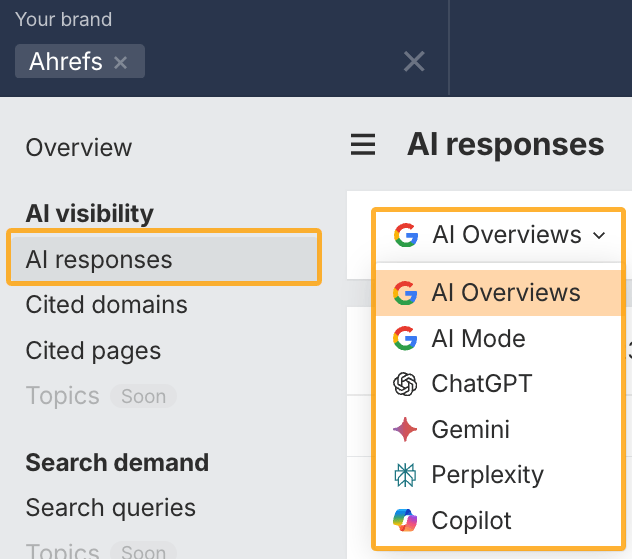
Track how closely AI connects your brand to key topics: Use tools like Brand Radar to filter queries and responses by your brand and topic, and see how often they co-occur. The stronger the overlap, the stronger the association.
Track hallucinations and inaccurate brand info in AI responses: Catch and correct false information before it spreads widely.
Final thoughts
Search is no longer a single channel. It’s a multi-layered ecosystem where Google, AI answers, social platforms, and user conversations all shape how your brand is discovered.
The good news? The fundamentals of SEO still matter.
Use this checklist as both a playbook and a compass: reinforce your foundation, adapt to AI search behaviors, and track your visibility across every platform that matters.
Similar Posts
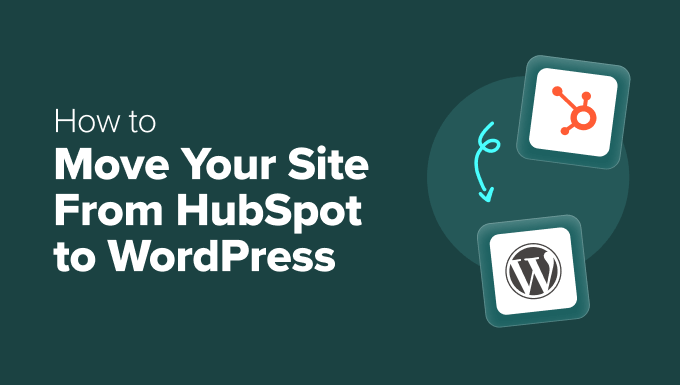
How to Move Your Site From HubSpot to WordPress (Step by Step)
When a close friend asked me to help move their business website from HubSpot to WordPress,…

The Crypto Hotline – BEST Cold Wallet Labor Day Deals (LIVE Q&A)
Labor Day Deals: Tangem – (20% OFF):https://tangem.com/en/pricing/?promocode=CYBERSCRILLA#pricing Enter both codes CYBERSCRILLA & LABORDAY at checkout. Ledger…
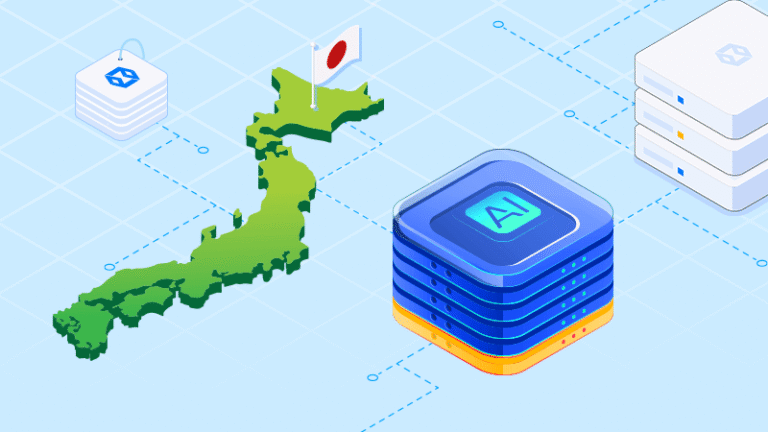
Steps to Deploy a Multi-GPU AI Server in Japan
The demand for advanced AI, deep learning, and data analytics solutions is accelerating across Asia-Pacific, with…

Summit Acquires HorizonIQ to Expand Bare-Metal and Cloud Scale
Summit is expanding its position in the managed infrastructure and cloud services market with the acquisition…

Shell Unveils DLC Fluid S3 for Advanced Data Center Cooling
Shell has unveiled a new direct liquid cooling (DLC) fluid designed to meet the rising thermal…
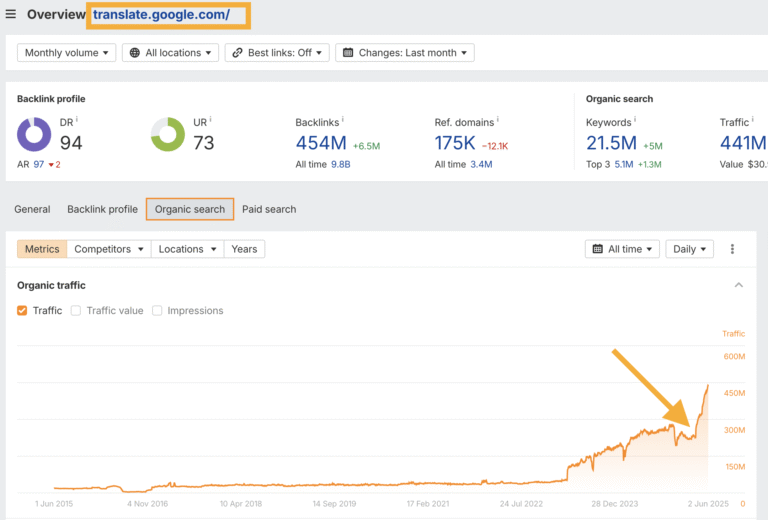
Google Is Stealing Your International Search Traffic With Automated Translations
Since the March Core update, there’s been a huge increase in Google’s efforts to automatically translate…
Audit current brand visibility around the web: Review how your brand appears across search, directories, and platforms to uncover inconsistencies like:
- Different brand names (e.g., Domain vs The Domain Group)
- Old logos or inconsistent taglines
- Old addresses or phone numbers
Benchmark your current visibility in AI search: Track how often your brand appears in AI-generated answers to establish a baseline for future growth.
Audit links and mentions around the web: Use tools like Ahrefs’ Site Explorer to find lost, unbranded, or broken links and reach out to the website owners to reclaim them. You can also use Brand Radar to audit your brand mentions. Benchmark the number of mentions and compare with competitors to spot gaps you can fill.
Audit your top pages visible in AI responses: Improve those that are underperforming, update those doing well, and improve their accuracy and business value.
Audit your content completeness and topic coverage: Use AI Content Helper to evaluate whether your content fully covers subtopics and intents, ensuring comprehensive topical authority.
Identify decaying content and update it: Refresh outdated pages with new information and links to recover rankings and preserve visibility in search and AI. To find decaying pages, look for:
data-nobefore
- Dropped rankings for relevant keywords
- Fewer mentions in AI responses for key terms
- Decreased organic and AI traffic in analytics
- Outdated data or information in the body content
Audit competitors to find gaps or new opportunities: Analyze competitor keywords, content, and formats to uncover areas where you can differentiate and outperform. Reverse engineer competitor visibility to find gaps to fill or new untapped opportunities.
- Do a brand gap analysis
- Do a content gap analysis
- Do a link gap analysis
See what AI says about your brand and if it’s true: Check the accuracy of AI answers about your brand to catch errors or misinformation early.
Do an AI brand gap analysis to close gaps against competitors: Compare your AI visibility with competitors and prioritize strategies to strengthen your presence.
Most SEO implementation (especially for AI search) relies on how you create and structure your content. Here are some things to think about for every page you create.
Build topical authority
- Publish original data like research and statistics: Release proprietary studies and benchmarks that attract authoritative backlinks and establish subject authority.
- Keep your most cited pages fresh and improve their business value: Regularly update pages that AI frequently cites and strengthen the business value of those pages to convert more visitors who find you in AI search.
- Close topic gaps to win visibility for new queries: Expand into emerging or missing subtopics to reinforce topical relevance and AI recognition.
- Create content hubs around core topics and long-tail keywords: Start by identifying your main pillar topic (e.g., ‘email marketing’) and then list related subtopics (e.g., ‘subject lines,’ ‘A/B testing,’ ‘deliverability’) to build cluster pages that link back to the pillar.
- Find questions to answer in your content: Find questions your audience is actively asking to capture demand in both traditional search and conversational, AI-driven search.
- Use Ahrefs’ Keywords Explorer to find common questions searched on Google
- Mine Google Search Console data for the questions people ask that lead to your site
- Use Answer the Public and Also Asked to find questions related to a given topic
- Analyze People Also Ask questions on Google for core keywords
- Review internal call transcripts and support tickets to find FAQs that existing customers ask
- Gather ‘voice of customer’ data via surveys and interviews
- Create an SEO topical map that extends beyond keywords: Start by identifying your core topics and related subtopics that have strong relevance to your brand and potential to drive traffic to your website. Map these topics to existing pages on your website or plan new pages to close topic gaps.
- Update your content strategy for AI search: Adapt planning and content strategy processes to prioritize AI-specific opportunities alongside SEO, like:
- Identifying pages or content hubs that should be cited in AI responses but aren’t
- Finding topic gaps against your competitors
- Uncovering untapped topics your competitors have yet to discover
Content quality and credibility
- Provide clear author or team bios and create dedicated pages: Publish detailed bios showcasing expertise to strengthen EEAT signals.
- Interview experts and quote them in your content: Add unique, authoritative perspectives that make content more trustworthy and AI-citable. Include expert quotes, cite and link recognized experts in your field, and reference authoritative sources in your content.
- Adapt your writing tone to match the content format: Tailor voice for blogs, guides, or sales content to improve resonance and engagement. For example, opt for a conversational tone where possible. Use a declarative tone when answering a question. Lean into an authoritative or expert tone for a ‘how to’ section and so on.
- Optimize content for actions or jobs-to-be-done instead of just questions: Frame content around outcomes and tasks, not just query-based answers. Then, instead of just writing an article that answers a query, give users a resource that helps them complete the action (e.g., a template for ‘creating a content calendar,’ or a calculator to ‘track ROI’).
- Define technical terms the first time you use them in content: Explain jargon concisely to make material accessible for broader audiences. It also sets the scene for AI systems to interpret and categorize your content correctly.
- Enrich content with original multimedia, like video, images, or audio: Add engaging formats that enhance experience and provide additional AI-referenced material. This can help secure visibility across more search surfaces that lean toward different types of content.
Structure and readability
- Emulate content formats AI frequently cites for your topic: Study successful content in AI responses and mirror those structures, such as step-by-step guides, comparison tables, checklists, FAQs, or how-to tutorials.
- Start your content with a TL;DR summary section: Provide condensed key takeaways upfront to help users and AI grasp value instantly. Here’s an example of what that looks like:

- Make sure your content is logically structured and scannable: Use clear sections, short paragraphs, and an information hierarchy that naturally leads from one section to the next. This helps readers (and AI) follow the flow of ideas without hitting dead ends or jarring jumps.
- Implement answer-oriented writing with one idea per section: Write clear, direct content with each section focused on a single point. Lead with the bottom line, then support it with context, anecdotes, or examples. This timeless writing approach now also improves visibility in both SEO and AI search.
- Use headings to create a logical content hierarchy: Organize content with a single H1 containing your primary keyword, supported by H2s and H3s that reflect the natural flow of topics. Headings should guide readers through the topic, making complex material easier to scan, while also helping search engines and AI understand context and relationships between sections. Do not apply heading tags purely for visual effect.
- Use bullet points, numbered lists, and tables to provide clarity: Present data in concise, structured content formats that improve both readability and snippet eligibility. For instance, avoid uploading tables as images. Use HTML or text-based tables so search engines and AI can read them.
- Add relevant FAQs for which you can write an original answer: Create FAQ sections that answer common user questions and that you can provide original, worthwhile answers to. The more your responses add information gain to the content, the more likely they will appear in AI search responses, too.
Classic on-page SEO
- Include a keyword in your page’s URL slug: Use short, descriptive slugs with the target keyword to strengthen relevance signals.
- Add a compelling title tag with the main keyword included: Write concise, keyword-rich titles that maximize click-throughs and topical alignment.
- Add a conversion-optimized meta description: Craft persuasive descriptions that highlight benefits and encourage clicks from SERPs.
- Internally link related pages and articles to each other: Add internal links between topically related pages on your website.
Content distribution & repurposing
- Repurpose your content and distribute on multiple platforms: Repurpose your top content into multiple formats (e.g., videos, carousels, podcasts, infographics) and distribute them across platforms that are gaining visibility in AI and search, like LinkedIn, YouTube, and Reddit. In short, squeeze multiple formats out of one winning piece of content and get it in front of more audiences.
Build links and brand mentions around the web: Earn references from trusted publications to strengthen authority and AI recognition.
Get links and mentions near topics that matter to your business: When backlinks and anchor text are tied to your core topics, they strengthen your topical authority instead of diluting it. Focus your outreach on sites, articles, and conversations where your brand naturally fits the topic, so search engines and AI associate you with those themes.
Partner with writers already getting cited in AI responses: Collaborate with authors frequently surfaced in AI answers to boost visibility in content already surfaced by search systems and discovered by humans. You can use the Cited pages report in Ahrefs’ Brand Radar to find top pages for your topic and then reach out to the people who wrote or edited them
Publish guest posts on publications with strong visibility in AI responses: Contribute content to outlets often cited by AI.
Create shareable assets that naturally attract links and mentions: Design tools, visuals, or templates people want to reference. Or share original thought leadership, thought-provoking opinion pieces, and data studies that can naturally attract links. For example, this data study by a marketing agency led to multiple links earned from major news outlets sharing news and updates about Taylor Swift’s jet emissions. 
Clean up inconsistent brand information or misinformation on third-party sites: Fix errors like outdated addresses, old logos, broken links, or incorrect descriptions to maintain trust and entity clarity.
Reclaim lost backlinks and mentions to maintain visibility: Track down broken or removed links on partner sites, news articles, or directories, and ask site owners to reinstate or update them.
Contribute to relevant conversations on forums and discussion threads: Join industry-specific spaces (e.g., Reddit communities, LinkedIn groups, or specialist forums) and answer questions where your expertise is useful. Be authentic and helpful so mentions of your brand feel natural.
Find the most cited pages for your topic and get mentions in them: Find pages AI frequently cites in its responses and add these to your link outreach so you can get mentions and links on them. Doing so could lead to faster increases in AI visibility for your brand.
Site Audit and schedule ongoing crawls: Run automated audits to catch issues before they impact visibility. The tool flags hundreds of potential problems and ranks them by importance, so you know what to fix first. Enterprises with large websites can also use Patches to resolve issues affecting search visibility without needing developer involvement.
Use HTTPS for content and website security: Secure your site with SSL to meet baseline ranking and trust signals.
Check robots.txt allows AI bots to access your content: Ensure you’re not accidentally blocking AI or search crawlers.
Update your XML sitemap and submit to Google and Bing: Keep sitemaps fresh to improve the discoverability of important pages.
Create a clean and crawlable site architecture: Organize navigation and hierarchy for better crawling and indexing.
Ensure fast-loading pages: Optimize performance for both user experience and rankings. Try optimizing file sizes, minifying CSS and JS, using browser caching, and implementing a content delivery network like Cloudflare.
If you use Cloudflare, check that it’s not blocking LLM access: Cloudflare has added many new settings controlling how AI platforms can access your website, often setting the default to block AI platforms. Check that these defaults aren’t applied to your account; otherwise, your website likely won’t surface in AI responses.
Measure and improve Core Web Vitals: Track and optimize loading, responsiveness, and stability metrics.
Implement structured data: Add schema to improve machine understanding of your content and how your pages appear in traditional search results. Semantic HTML can also help turn your content into structured data that search engines and AI systems can interpret more accurately.
Apply hreflang for multilingual and/or multiregional content: Use hreflang to deliver correct content versions internationally.
Optimize your images for speed and performance and add alt text: Compress and label images for accessibility, SEO, and AI recognition.
Use server-side rendering for visibility to search and AI crawlers: Pre-rendered pages ensure search engines and AI systems can index everything, even if your site relies heavily on JavaScript.
Prioritize mobile-first and responsive design on mobile devices: Build mobile experiences as the default for indexing and AI.
Redirect broken pages and URLs hallucinated by AI: Catch errors and direct users to relevant content.
Create and optimize business profiles on Google, Bing, and Apple Maps: Claim and complete listings with accurate information.
Create location pages on your website: Publish content for individual cities or regions to strengthen local rankings.
Ensure consistent name, address, and phone number (NAP): Keep NAP data standardized everywhere your business appears online.
Build localized citations in your region: Submit consistent NAP information across trusted directories like Yelp, Yellow Pages, or industry-specific sites.
Keep your business profiles updated and post on them regularly: Maintain active listings to improve visibility and AI trust, as well as to provide accurate information to searchers in your area.
Web Analytics to measure your website traffic: Track organic, paid, and AI performance. Find pages earning the most traffic and conversions.
Set up Google Search Console and Bing Webmaster Tools: Gain insights into indexing, crawling, and performance issues.
Set up your internal reporting dashboard to measure brand awareness: Centralize reporting on branded search and mentions.
Monitor your top pages and organic traffic from SEO and AI: Track performance of priority content across both ecosystems. You can do this using Ahrefs’ Web Analytics:
Check out the list of top pages by each channel to see which perform best in traditional SEO results vs in AI search specifically.

Track rankings in the top 20 organic positions: Monitor keyword movement in the top ranking spots to assess meaningful gains and losses.
Track growth in links and mentions around the web: Use Ahrefs’ Brand Radar > Web visibility report to see whether your brand is earning more backlinks, citations, and references over time. 
Measure your AI Share of Voice compared to competitors: Benchmark your presence against rivals in AI search. 
Measure your brand’s appearances in AI answers: Track frequency of AI citations, including your brand across platforms. You can do this in Ahrefs’ Brand Radar > AI responses report: 
Track how closely AI connects your brand to key topics: Use tools like Brand Radar to filter queries and responses by your brand and topic, and see how often they co-occur. The stronger the overlap, the stronger the association.
Track hallucinations and inaccurate brand info in AI responses: Catch and correct false information before it spreads widely.
Final thoughts
Search is no longer a single channel. It’s a multi-layered ecosystem where Google, AI answers, social platforms, and user conversations all shape how your brand is discovered.
The good news? The fundamentals of SEO still matter.
Use this checklist as both a playbook and a compass: reinforce your foundation, adapt to AI search behaviors, and track your visibility across every platform that matters.
Similar Posts

How to Move Your Site From HubSpot to WordPress (Step by Step)
When a close friend asked me to help move their business website from HubSpot to WordPress,…

The Crypto Hotline – BEST Cold Wallet Labor Day Deals (LIVE Q&A)
Labor Day Deals: Tangem – (20% OFF):https://tangem.com/en/pricing/?promocode=CYBERSCRILLA#pricing Enter both codes CYBERSCRILLA & LABORDAY at checkout. Ledger…

Steps to Deploy a Multi-GPU AI Server in Japan
The demand for advanced AI, deep learning, and data analytics solutions is accelerating across Asia-Pacific, with…

Summit Acquires HorizonIQ to Expand Bare-Metal and Cloud Scale
Summit is expanding its position in the managed infrastructure and cloud services market with the acquisition…

Shell Unveils DLC Fluid S3 for Advanced Data Center Cooling
Shell has unveiled a new direct liquid cooling (DLC) fluid designed to meet the rising thermal…

Google Is Stealing Your International Search Traffic With Automated Translations
Since the March Core update, there’s been a huge increase in Google’s efforts to automatically translate…
- Different brand names (e.g., Domain vs The Domain Group)
- Old logos or inconsistent taglines
- Old addresses or phone numbers
data-nobefore
- Dropped rankings for relevant keywords
- Fewer mentions in AI responses for key terms
- Decreased organic and AI traffic in analytics
- Outdated data or information in the body content
- Do a brand gap analysis
- Do a content gap analysis
- Do a link gap analysis
Most SEO implementation (especially for AI search) relies on how you create and structure your content. Here are some things to think about for every page you create.
Build topical authority
- Publish original data like research and statistics: Release proprietary studies and benchmarks that attract authoritative backlinks and establish subject authority.
- Keep your most cited pages fresh and improve their business value: Regularly update pages that AI frequently cites and strengthen the business value of those pages to convert more visitors who find you in AI search.
- Close topic gaps to win visibility for new queries: Expand into emerging or missing subtopics to reinforce topical relevance and AI recognition.
- Create content hubs around core topics and long-tail keywords: Start by identifying your main pillar topic (e.g., ‘email marketing’) and then list related subtopics (e.g., ‘subject lines,’ ‘A/B testing,’ ‘deliverability’) to build cluster pages that link back to the pillar.
- Find questions to answer in your content: Find questions your audience is actively asking to capture demand in both traditional search and conversational, AI-driven search.
- Use Ahrefs’ Keywords Explorer to find common questions searched on Google
- Mine Google Search Console data for the questions people ask that lead to your site
- Use Answer the Public and Also Asked to find questions related to a given topic
- Analyze People Also Ask questions on Google for core keywords
- Review internal call transcripts and support tickets to find FAQs that existing customers ask
- Gather ‘voice of customer’ data via surveys and interviews
- Create an SEO topical map that extends beyond keywords: Start by identifying your core topics and related subtopics that have strong relevance to your brand and potential to drive traffic to your website. Map these topics to existing pages on your website or plan new pages to close topic gaps.
- Update your content strategy for AI search: Adapt planning and content strategy processes to prioritize AI-specific opportunities alongside SEO, like:
- Identifying pages or content hubs that should be cited in AI responses but aren’t
- Finding topic gaps against your competitors
- Uncovering untapped topics your competitors have yet to discover
Content quality and credibility
- Provide clear author or team bios and create dedicated pages: Publish detailed bios showcasing expertise to strengthen EEAT signals.
- Interview experts and quote them in your content: Add unique, authoritative perspectives that make content more trustworthy and AI-citable. Include expert quotes, cite and link recognized experts in your field, and reference authoritative sources in your content.
- Adapt your writing tone to match the content format: Tailor voice for blogs, guides, or sales content to improve resonance and engagement. For example, opt for a conversational tone where possible. Use a declarative tone when answering a question. Lean into an authoritative or expert tone for a ‘how to’ section and so on.
- Optimize content for actions or jobs-to-be-done instead of just questions: Frame content around outcomes and tasks, not just query-based answers. Then, instead of just writing an article that answers a query, give users a resource that helps them complete the action (e.g., a template for ‘creating a content calendar,’ or a calculator to ‘track ROI’).
- Define technical terms the first time you use them in content: Explain jargon concisely to make material accessible for broader audiences. It also sets the scene for AI systems to interpret and categorize your content correctly.
- Enrich content with original multimedia, like video, images, or audio: Add engaging formats that enhance experience and provide additional AI-referenced material. This can help secure visibility across more search surfaces that lean toward different types of content.
Structure and readability
- Emulate content formats AI frequently cites for your topic: Study successful content in AI responses and mirror those structures, such as step-by-step guides, comparison tables, checklists, FAQs, or how-to tutorials.
- Start your content with a TL;DR summary section: Provide condensed key takeaways upfront to help users and AI grasp value instantly. Here’s an example of what that looks like:

- Make sure your content is logically structured and scannable: Use clear sections, short paragraphs, and an information hierarchy that naturally leads from one section to the next. This helps readers (and AI) follow the flow of ideas without hitting dead ends or jarring jumps.
- Implement answer-oriented writing with one idea per section: Write clear, direct content with each section focused on a single point. Lead with the bottom line, then support it with context, anecdotes, or examples. This timeless writing approach now also improves visibility in both SEO and AI search.
- Use headings to create a logical content hierarchy: Organize content with a single H1 containing your primary keyword, supported by H2s and H3s that reflect the natural flow of topics. Headings should guide readers through the topic, making complex material easier to scan, while also helping search engines and AI understand context and relationships between sections. Do not apply heading tags purely for visual effect.
- Use bullet points, numbered lists, and tables to provide clarity: Present data in concise, structured content formats that improve both readability and snippet eligibility. For instance, avoid uploading tables as images. Use HTML or text-based tables so search engines and AI can read them.
- Add relevant FAQs for which you can write an original answer: Create FAQ sections that answer common user questions and that you can provide original, worthwhile answers to. The more your responses add information gain to the content, the more likely they will appear in AI search responses, too.
Classic on-page SEO
- Include a keyword in your page’s URL slug: Use short, descriptive slugs with the target keyword to strengthen relevance signals.
- Add a compelling title tag with the main keyword included: Write concise, keyword-rich titles that maximize click-throughs and topical alignment.
- Add a conversion-optimized meta description: Craft persuasive descriptions that highlight benefits and encourage clicks from SERPs.
- Internally link related pages and articles to each other: Add internal links between topically related pages on your website.
Content distribution & repurposing
- Repurpose your content and distribute on multiple platforms: Repurpose your top content into multiple formats (e.g., videos, carousels, podcasts, infographics) and distribute them across platforms that are gaining visibility in AI and search, like LinkedIn, YouTube, and Reddit. In short, squeeze multiple formats out of one winning piece of content and get it in front of more audiences.
Build links and brand mentions around the web: Earn references from trusted publications to strengthen authority and AI recognition.
Get links and mentions near topics that matter to your business: When backlinks and anchor text are tied to your core topics, they strengthen your topical authority instead of diluting it. Focus your outreach on sites, articles, and conversations where your brand naturally fits the topic, so search engines and AI associate you with those themes.
Partner with writers already getting cited in AI responses: Collaborate with authors frequently surfaced in AI answers to boost visibility in content already surfaced by search systems and discovered by humans. You can use the Cited pages report in Ahrefs’ Brand Radar to find top pages for your topic and then reach out to the people who wrote or edited them
Publish guest posts on publications with strong visibility in AI responses: Contribute content to outlets often cited by AI.
Create shareable assets that naturally attract links and mentions: Design tools, visuals, or templates people want to reference. Or share original thought leadership, thought-provoking opinion pieces, and data studies that can naturally attract links. For example, this data study by a marketing agency led to multiple links earned from major news outlets sharing news and updates about Taylor Swift’s jet emissions. 
Clean up inconsistent brand information or misinformation on third-party sites: Fix errors like outdated addresses, old logos, broken links, or incorrect descriptions to maintain trust and entity clarity.
Reclaim lost backlinks and mentions to maintain visibility: Track down broken or removed links on partner sites, news articles, or directories, and ask site owners to reinstate or update them.
Contribute to relevant conversations on forums and discussion threads: Join industry-specific spaces (e.g., Reddit communities, LinkedIn groups, or specialist forums) and answer questions where your expertise is useful. Be authentic and helpful so mentions of your brand feel natural.
Find the most cited pages for your topic and get mentions in them: Find pages AI frequently cites in its responses and add these to your link outreach so you can get mentions and links on them. Doing so could lead to faster increases in AI visibility for your brand.
Site Audit and schedule ongoing crawls: Run automated audits to catch issues before they impact visibility. The tool flags hundreds of potential problems and ranks them by importance, so you know what to fix first. Enterprises with large websites can also use Patches to resolve issues affecting search visibility without needing developer involvement.
Use HTTPS for content and website security: Secure your site with SSL to meet baseline ranking and trust signals.
Check robots.txt allows AI bots to access your content: Ensure you’re not accidentally blocking AI or search crawlers.
Update your XML sitemap and submit to Google and Bing: Keep sitemaps fresh to improve the discoverability of important pages.
Create a clean and crawlable site architecture: Organize navigation and hierarchy for better crawling and indexing.
Ensure fast-loading pages: Optimize performance for both user experience and rankings. Try optimizing file sizes, minifying CSS and JS, using browser caching, and implementing a content delivery network like Cloudflare.
If you use Cloudflare, check that it’s not blocking LLM access: Cloudflare has added many new settings controlling how AI platforms can access your website, often setting the default to block AI platforms. Check that these defaults aren’t applied to your account; otherwise, your website likely won’t surface in AI responses.
Measure and improve Core Web Vitals: Track and optimize loading, responsiveness, and stability metrics.
Implement structured data: Add schema to improve machine understanding of your content and how your pages appear in traditional search results. Semantic HTML can also help turn your content into structured data that search engines and AI systems can interpret more accurately.
Apply hreflang for multilingual and/or multiregional content: Use hreflang to deliver correct content versions internationally.
Optimize your images for speed and performance and add alt text: Compress and label images for accessibility, SEO, and AI recognition.
Use server-side rendering for visibility to search and AI crawlers: Pre-rendered pages ensure search engines and AI systems can index everything, even if your site relies heavily on JavaScript.
Prioritize mobile-first and responsive design on mobile devices: Build mobile experiences as the default for indexing and AI.
Redirect broken pages and URLs hallucinated by AI: Catch errors and direct users to relevant content.
Create and optimize business profiles on Google, Bing, and Apple Maps: Claim and complete listings with accurate information.
Create location pages on your website: Publish content for individual cities or regions to strengthen local rankings.
Ensure consistent name, address, and phone number (NAP): Keep NAP data standardized everywhere your business appears online.
Build localized citations in your region: Submit consistent NAP information across trusted directories like Yelp, Yellow Pages, or industry-specific sites.
Keep your business profiles updated and post on them regularly: Maintain active listings to improve visibility and AI trust, as well as to provide accurate information to searchers in your area.
Web Analytics to measure your website traffic: Track organic, paid, and AI performance. Find pages earning the most traffic and conversions.
Set up Google Search Console and Bing Webmaster Tools: Gain insights into indexing, crawling, and performance issues.
Set up your internal reporting dashboard to measure brand awareness: Centralize reporting on branded search and mentions.
Monitor your top pages and organic traffic from SEO and AI: Track performance of priority content across both ecosystems. You can do this using Ahrefs’ Web Analytics:
Check out the list of top pages by each channel to see which perform best in traditional SEO results vs in AI search specifically.

Track rankings in the top 20 organic positions: Monitor keyword movement in the top ranking spots to assess meaningful gains and losses.
Track growth in links and mentions around the web: Use Ahrefs’ Brand Radar > Web visibility report to see whether your brand is earning more backlinks, citations, and references over time. 
Measure your AI Share of Voice compared to competitors: Benchmark your presence against rivals in AI search. 
Measure your brand’s appearances in AI answers: Track frequency of AI citations, including your brand across platforms. You can do this in Ahrefs’ Brand Radar > AI responses report: 
Track how closely AI connects your brand to key topics: Use tools like Brand Radar to filter queries and responses by your brand and topic, and see how often they co-occur. The stronger the overlap, the stronger the association.
Track hallucinations and inaccurate brand info in AI responses: Catch and correct false information before it spreads widely.
Final thoughts
Search is no longer a single channel. It’s a multi-layered ecosystem where Google, AI answers, social platforms, and user conversations all shape how your brand is discovered.
The good news? The fundamentals of SEO still matter.
Use this checklist as both a playbook and a compass: reinforce your foundation, adapt to AI search behaviors, and track your visibility across every platform that matters.
Similar Posts

How to Move Your Site From HubSpot to WordPress (Step by Step)
When a close friend asked me to help move their business website from HubSpot to WordPress,…

The Crypto Hotline – BEST Cold Wallet Labor Day Deals (LIVE Q&A)
Labor Day Deals: Tangem – (20% OFF):https://tangem.com/en/pricing/?promocode=CYBERSCRILLA#pricing Enter both codes CYBERSCRILLA & LABORDAY at checkout. Ledger…

Steps to Deploy a Multi-GPU AI Server in Japan
The demand for advanced AI, deep learning, and data analytics solutions is accelerating across Asia-Pacific, with…

Summit Acquires HorizonIQ to Expand Bare-Metal and Cloud Scale
Summit is expanding its position in the managed infrastructure and cloud services market with the acquisition…

Shell Unveils DLC Fluid S3 for Advanced Data Center Cooling
Shell has unveiled a new direct liquid cooling (DLC) fluid designed to meet the rising thermal…

Google Is Stealing Your International Search Traffic With Automated Translations
Since the March Core update, there’s been a huge increase in Google’s efforts to automatically translate…

Site Audit and schedule ongoing crawls: Run automated audits to catch issues before they impact visibility. The tool flags hundreds of potential problems and ranks them by importance, so you know what to fix first. Enterprises with large websites can also use Patches to resolve issues affecting search visibility without needing developer involvement.
Use HTTPS for content and website security: Secure your site with SSL to meet baseline ranking and trust signals.
Check robots.txt allows AI bots to access your content: Ensure you’re not accidentally blocking AI or search crawlers.
Update your XML sitemap and submit to Google and Bing: Keep sitemaps fresh to improve the discoverability of important pages.
Create a clean and crawlable site architecture: Organize navigation and hierarchy for better crawling and indexing.
Ensure fast-loading pages: Optimize performance for both user experience and rankings. Try optimizing file sizes, minifying CSS and JS, using browser caching, and implementing a content delivery network like Cloudflare.
If you use Cloudflare, check that it’s not blocking LLM access: Cloudflare has added many new settings controlling how AI platforms can access your website, often setting the default to block AI platforms. Check that these defaults aren’t applied to your account; otherwise, your website likely won’t surface in AI responses.
Measure and improve Core Web Vitals: Track and optimize loading, responsiveness, and stability metrics.
Implement structured data: Add schema to improve machine understanding of your content and how your pages appear in traditional search results. Semantic HTML can also help turn your content into structured data that search engines and AI systems can interpret more accurately.
Apply hreflang for multilingual and/or multiregional content: Use hreflang to deliver correct content versions internationally.
Optimize your images for speed and performance and add alt text: Compress and label images for accessibility, SEO, and AI recognition.
Use server-side rendering for visibility to search and AI crawlers: Pre-rendered pages ensure search engines and AI systems can index everything, even if your site relies heavily on JavaScript.
Prioritize mobile-first and responsive design on mobile devices: Build mobile experiences as the default for indexing and AI.
Redirect broken pages and URLs hallucinated by AI: Catch errors and direct users to relevant content.
Create and optimize business profiles on Google, Bing, and Apple Maps: Claim and complete listings with accurate information.
Create location pages on your website: Publish content for individual cities or regions to strengthen local rankings.
Ensure consistent name, address, and phone number (NAP): Keep NAP data standardized everywhere your business appears online.
Build localized citations in your region: Submit consistent NAP information across trusted directories like Yelp, Yellow Pages, or industry-specific sites.
Keep your business profiles updated and post on them regularly: Maintain active listings to improve visibility and AI trust, as well as to provide accurate information to searchers in your area.
Web Analytics to measure your website traffic: Track organic, paid, and AI performance. Find pages earning the most traffic and conversions.
Set up Google Search Console and Bing Webmaster Tools: Gain insights into indexing, crawling, and performance issues.
Set up your internal reporting dashboard to measure brand awareness: Centralize reporting on branded search and mentions.
Monitor your top pages and organic traffic from SEO and AI: Track performance of priority content across both ecosystems. You can do this using Ahrefs’ Web Analytics:
Check out the list of top pages by each channel to see which perform best in traditional SEO results vs in AI search specifically.

Track rankings in the top 20 organic positions: Monitor keyword movement in the top ranking spots to assess meaningful gains and losses.
Track growth in links and mentions around the web: Use Ahrefs’ Brand Radar > Web visibility report to see whether your brand is earning more backlinks, citations, and references over time. 
Measure your AI Share of Voice compared to competitors: Benchmark your presence against rivals in AI search. 
Measure your brand’s appearances in AI answers: Track frequency of AI citations, including your brand across platforms. You can do this in Ahrefs’ Brand Radar > AI responses report: 
Track how closely AI connects your brand to key topics: Use tools like Brand Radar to filter queries and responses by your brand and topic, and see how often they co-occur. The stronger the overlap, the stronger the association.
Track hallucinations and inaccurate brand info in AI responses: Catch and correct false information before it spreads widely.
Final thoughts
Search is no longer a single channel. It’s a multi-layered ecosystem where Google, AI answers, social platforms, and user conversations all shape how your brand is discovered.
The good news? The fundamentals of SEO still matter.
Use this checklist as both a playbook and a compass: reinforce your foundation, adapt to AI search behaviors, and track your visibility across every platform that matters.
Similar Posts

How to Move Your Site From HubSpot to WordPress (Step by Step)
When a close friend asked me to help move their business website from HubSpot to WordPress,…

The Crypto Hotline – BEST Cold Wallet Labor Day Deals (LIVE Q&A)
Labor Day Deals: Tangem – (20% OFF):https://tangem.com/en/pricing/?promocode=CYBERSCRILLA#pricing Enter both codes CYBERSCRILLA & LABORDAY at checkout. Ledger…

Steps to Deploy a Multi-GPU AI Server in Japan
The demand for advanced AI, deep learning, and data analytics solutions is accelerating across Asia-Pacific, with…

Summit Acquires HorizonIQ to Expand Bare-Metal and Cloud Scale
Summit is expanding its position in the managed infrastructure and cloud services market with the acquisition…

Shell Unveils DLC Fluid S3 for Advanced Data Center Cooling
Shell has unveiled a new direct liquid cooling (DLC) fluid designed to meet the rising thermal…

Google Is Stealing Your International Search Traffic With Automated Translations
Since the March Core update, there’s been a huge increase in Google’s efforts to automatically translate…
Create and optimize business profiles on Google, Bing, and Apple Maps: Claim and complete listings with accurate information.
Create location pages on your website: Publish content for individual cities or regions to strengthen local rankings.
Ensure consistent name, address, and phone number (NAP): Keep NAP data standardized everywhere your business appears online.
Build localized citations in your region: Submit consistent NAP information across trusted directories like Yelp, Yellow Pages, or industry-specific sites.
Keep your business profiles updated and post on them regularly: Maintain active listings to improve visibility and AI trust, as well as to provide accurate information to searchers in your area.
Web Analytics to measure your website traffic: Track organic, paid, and AI performance. Find pages earning the most traffic and conversions.
Set up Google Search Console and Bing Webmaster Tools: Gain insights into indexing, crawling, and performance issues.
Set up your internal reporting dashboard to measure brand awareness: Centralize reporting on branded search and mentions.
Monitor your top pages and organic traffic from SEO and AI: Track performance of priority content across both ecosystems. You can do this using Ahrefs’ Web Analytics:
Check out the list of top pages by each channel to see which perform best in traditional SEO results vs in AI search specifically.

Track rankings in the top 20 organic positions: Monitor keyword movement in the top ranking spots to assess meaningful gains and losses.
Track growth in links and mentions around the web: Use Ahrefs’ Brand Radar > Web visibility report to see whether your brand is earning more backlinks, citations, and references over time. 
Measure your AI Share of Voice compared to competitors: Benchmark your presence against rivals in AI search. 
Measure your brand’s appearances in AI answers: Track frequency of AI citations, including your brand across platforms. You can do this in Ahrefs’ Brand Radar > AI responses report: 
Track how closely AI connects your brand to key topics: Use tools like Brand Radar to filter queries and responses by your brand and topic, and see how often they co-occur. The stronger the overlap, the stronger the association.
Track hallucinations and inaccurate brand info in AI responses: Catch and correct false information before it spreads widely.
Final thoughts
Search is no longer a single channel. It’s a multi-layered ecosystem where Google, AI answers, social platforms, and user conversations all shape how your brand is discovered.
The good news? The fundamentals of SEO still matter.
Use this checklist as both a playbook and a compass: reinforce your foundation, adapt to AI search behaviors, and track your visibility across every platform that matters.
Similar Posts

How to Move Your Site From HubSpot to WordPress (Step by Step)
When a close friend asked me to help move their business website from HubSpot to WordPress,…

The Crypto Hotline – BEST Cold Wallet Labor Day Deals (LIVE Q&A)
Labor Day Deals: Tangem – (20% OFF):https://tangem.com/en/pricing/?promocode=CYBERSCRILLA#pricing Enter both codes CYBERSCRILLA & LABORDAY at checkout. Ledger…

Steps to Deploy a Multi-GPU AI Server in Japan
The demand for advanced AI, deep learning, and data analytics solutions is accelerating across Asia-Pacific, with…

Summit Acquires HorizonIQ to Expand Bare-Metal and Cloud Scale
Summit is expanding its position in the managed infrastructure and cloud services market with the acquisition…

Shell Unveils DLC Fluid S3 for Advanced Data Center Cooling
Shell has unveiled a new direct liquid cooling (DLC) fluid designed to meet the rising thermal…

Google Is Stealing Your International Search Traffic With Automated Translations
Since the March Core update, there’s been a huge increase in Google’s efforts to automatically translate…
Web Analytics to measure your website traffic: Track organic, paid, and AI performance. Find pages earning the most traffic and conversions.
Set up Google Search Console and Bing Webmaster Tools: Gain insights into indexing, crawling, and performance issues.
Set up your internal reporting dashboard to measure brand awareness: Centralize reporting on branded search and mentions.
Monitor your top pages and organic traffic from SEO and AI: Track performance of priority content across both ecosystems. You can do this using Ahrefs’ Web Analytics:
Check out the list of top pages by each channel to see which perform best in traditional SEO results vs in AI search specifically.

Track rankings in the top 20 organic positions: Monitor keyword movement in the top ranking spots to assess meaningful gains and losses.
Track growth in links and mentions around the web: Use Ahrefs’ Brand Radar > Web visibility report to see whether your brand is earning more backlinks, citations, and references over time. 
Measure your AI Share of Voice compared to competitors: Benchmark your presence against rivals in AI search. 
Measure your brand’s appearances in AI answers: Track frequency of AI citations, including your brand across platforms. You can do this in Ahrefs’ Brand Radar > AI responses report: 
Track how closely AI connects your brand to key topics: Use tools like Brand Radar to filter queries and responses by your brand and topic, and see how often they co-occur. The stronger the overlap, the stronger the association.
Track hallucinations and inaccurate brand info in AI responses: Catch and correct false information before it spreads widely.
Final thoughts
Search is no longer a single channel. It’s a multi-layered ecosystem where Google, AI answers, social platforms, and user conversations all shape how your brand is discovered.
The good news? The fundamentals of SEO still matter.
Use this checklist as both a playbook and a compass: reinforce your foundation, adapt to AI search behaviors, and track your visibility across every platform that matters.

Check out the list of top pages by each channel to see which perform best in traditional SEO results vs in AI search specifically.




Final thoughts
Search is no longer a single channel. It’s a multi-layered ecosystem where Google, AI answers, social platforms, and user conversations all shape how your brand is discovered.
The good news? The fundamentals of SEO still matter.
Use this checklist as both a playbook and a compass: reinforce your foundation, adapt to AI search behaviors, and track your visibility across every platform that matters.
Similar Posts

How to Move Your Site From HubSpot to WordPress (Step by Step)
When a close friend asked me to help move their business website from HubSpot to WordPress,…

The Crypto Hotline – BEST Cold Wallet Labor Day Deals (LIVE Q&A)
Labor Day Deals: Tangem – (20% OFF):https://tangem.com/en/pricing/?promocode=CYBERSCRILLA#pricing Enter both codes CYBERSCRILLA & LABORDAY at checkout. Ledger…

Steps to Deploy a Multi-GPU AI Server in Japan
The demand for advanced AI, deep learning, and data analytics solutions is accelerating across Asia-Pacific, with…

Summit Acquires HorizonIQ to Expand Bare-Metal and Cloud Scale
Summit is expanding its position in the managed infrastructure and cloud services market with the acquisition…

Shell Unveils DLC Fluid S3 for Advanced Data Center Cooling
Shell has unveiled a new direct liquid cooling (DLC) fluid designed to meet the rising thermal…

Google Is Stealing Your International Search Traffic With Automated Translations
Since the March Core update, there’s been a huge increase in Google’s efforts to automatically translate…